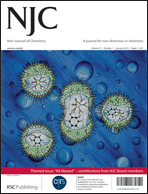在 NADH 和 ATP 存在下,利用多酶系统从丙酮酸和低浓度 CO2 生成富马酸盐
IF 2.7
3区 化学
Q2 CHEMISTRY, MULTIDISCIPLINARY
引用次数: 0
摘要
富马酸是一种不饱和二羧酸,可用作不饱和聚酯树脂、聚丁二酸丁二醇酯(PBS)、聚富马酸丙二醇酯(PPF)、增塑剂等的原料。由富马酸酯制成的生物降解塑料是解决塑料废弃物造成的严重环境污染问题的一个极具吸引力的方案。在环境温度和压力下,利用酶在水介质中从二氧化碳和生物基丙酮酸中生产新型富马酸盐,是解决塑料污染以及二氧化碳捕获、利用和储存(CCUS)的一种环保方法。在这项研究中,在 4-(2-羟乙基)-1-哌嗪乙磺酸(HEPES)-NaOH 缓冲溶液中,利用由牛肝丙酮酸羧化酶(PC;EC 6.4.1.1)、重组自细菌的苹果酸脱氢酶(MDH;EC 1.1.1.37)和来自猪心的富马酸酶(FUM;EC 1.1.1.37)组成的多酶系统在腺苷-5'-三磷酸(ATP)和 NADH 存在下的反应进行了研究。研究发现,在 ATP 和 NADH 的存在下,利用 PC 和 MDH 组成的双酶系统,直接使用相当于废气的 15%的 CO2 作为羧化剂,经过 5 小时的培养,丙酮酸可以高产率(超过 80%)转化为 L-苹果酸。此外,以 15%的二氧化碳和丙酮酸为原料,利用 PC 和 MDH 组成的双酶系统还开发了富马酸的生产。本文章由计算机程序翻译,如有差异,请以英文原文为准。
Fumarate production from pyruvate and low concentrations of CO2 with the multi-enzymatic system in the presence of NADH and ATP
Fumarate is an unsaturated dicarboxylic acid useful as raw materials for unsaturated polyester resins, polybutylene succinate (PBS), poly(propylene fumarate)(PPF), plasticisers and so on. Biodegradable plastics made from fumarate are an attractive solution to the serious environmental pollution caused by plastic disposal. A new fumarate production from CO2 and biobased pyruvate using enzymes in aqueous media under ambient temperature and pressure is an environmental approach for both plastic pollution, and CO2 capture, utilization and storage (CCUS). In this work, the fumarate production from pyruvate and low-concentration CO2 below 15% captured from the gas phase by the 4-(2-hydroxyethyl)-1-piperazineethanesulfonic acid (HEPES)-NaOH buffer solution with the multi-enzyme system consisting of pyruvate carboxylase from bovine liver (PC; EC 6.4.1.1), malate dehydrogenase recombinant from Bacteria (MDH; EC 1.1.1.37) and fumarase from porcine heart (FUM; EC 1.1.1.37) in the presence of adenosine 5’-triphosphate (ATP) and NADH was investigated. It was found that pyruvate can be converted into L-malate in high yield (more than 80 %) by directly using 15% CO2 equivalent to exhaust gas as a carboxylating agent by using dual-enzyme system consisting of PC and MDH in the presence of ATP and NADH after 5 h incubation. Moreover, the development of fumarate production from 15% CO2 and pyruvate as raw materials also was accomplished by using dual-enzyme system consisting of PC and MDH.
求助全文
通过发布文献求助,成功后即可免费获取论文全文。
去求助
来源期刊

New Journal of Chemistry
化学-化学综合
CiteScore
5.30
自引率
6.10%
发文量
1832
审稿时长
2 months
期刊介绍:
A journal for new directions in chemistry
 求助内容:
求助内容: 应助结果提醒方式:
应助结果提醒方式:


